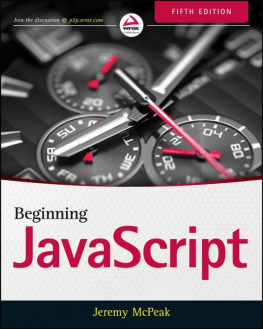Shelley Powers [Shelley Powers] - Learning JavaScript, 2nd Edition
Here you can read online Shelley Powers [Shelley Powers] - Learning JavaScript, 2nd Edition full text of the book (entire story) in english for free. Download pdf and epub, get meaning, cover and reviews about this ebook. year: 2008, publisher: O’Reilly Media, Inc., genre: Computer. Description of the work, (preface) as well as reviews are available. Best literature library LitArk.com created for fans of good reading and offers a wide selection of genres:
Romance novel
Science fiction
Adventure
Detective
Science
History
Home and family
Prose
Art
Politics
Computer
Non-fiction
Religion
Business
Children
Humor
Choose a favorite category and find really read worthwhile books. Enjoy immersion in the world of imagination, feel the emotions of the characters or learn something new for yourself, make an fascinating discovery.
- Book:Learning JavaScript, 2nd Edition
- Author:
- Publisher:O’Reilly Media, Inc.
- Genre:
- Year:2008
- Rating:3 / 5
- Favourites:Add to favourites
- Your mark:
Learning JavaScript, 2nd Edition: summary, description and annotation
We offer to read an annotation, description, summary or preface (depends on what the author of the book "Learning JavaScript, 2nd Edition" wrote himself). If you haven't found the necessary information about the book — write in the comments, we will try to find it.
If youre new to JavaScript, or an experienced web developer looking to improve your skills, Learning JavaScript provides you with complete, no-nonsense coverage of this quirky yet essential language for web development. Youll learn everything from primitive data types to complex features, including JavaScript elements involved with Ajax and dynamic page effects. By the end of the book, youll be able to work with even the most sophisticated libraries and web applications.
Complete with best practices and examples of JavaScript use, this new edition shows you how to integrate the language with the browser environment, and how to practice proper coding techniques for standards-compliant websites. This book will help you:
- Learn the JavaScript application structure, including basic statements and control structures
- Identify JavaScript objectsString, Number, Boolean, Function, and more
- Use browser debugging tools and troubleshooting techniques
- Understand event handling, form events, and JavaScript applications with forms
- Develop with the Browser Object Model, the Document Object Model, and custom objects you create
- Learn about browser cookies and more modern client-side storage techniques
- Get details for using XML or JSON with Ajax applications
Shelley Powers [Shelley Powers]: author's other books
Who wrote Learning JavaScript, 2nd Edition? Find out the surname, the name of the author of the book and a list of all author's works by series.

![Shelley Powers [Shelley Powers] Learning JavaScript, 2nd Edition](/uploads/posts/book/120570/thumbs/shelley-powers-shelley-powers-learning.jpg)



![Nicholas C. Zakas [Nicholas C. Zakas] - Professional: JavaScript® for Web Developers, Third Edition](/uploads/posts/book/121419/thumbs/nicholas-c-zakas-nicholas-c-zakas.jpg)





